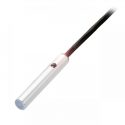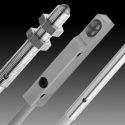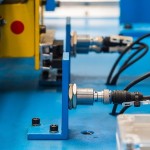For many industries, their machines work under highly demanding environments. That’s why they need sensors that can reliably perform under challenging circumstances. By using ceramic coating, a new range of weld-immune inductive sensors offer to do just that. What are inductive sensors? Inductive sensors are used to detect the presence of a metallic object. Vacuum-sealed… Read more »
Understanding the Different Types of Capacitive Sensors
Capacitive sensors are proximity sensors, offering non-contact detection of a target. Capacitive sensing involves the electrical property of capacitance and the resulting feedback present in the oscillator circuit created between the target and the sensor. Not only can capacitive sensors detect the presence or absence of an object, but they can also detect flow, liquid… Read more »
High-Pressure Inductive Sensors Are Small but Remarkably Strong
At Locon Sensor Systems, we recognize the need for variety of industrial-grade sensor options that are capable of operating reliably even in the most unforgiving environments. From high-temperature tolerant sensors to washdown sensors that are food safe and corrosion resistant, we provide rugged and durable sensor solutions. We are pleased to offer pressure-resistant inductive sensors… Read more »
Miniature Photoelectric Sensors Offer an Alternative to Fiber Optic Cables
In robotics and other applications where space is very limited, engineers sometimes need to use fiber optic cables paired with conventional photoelectric sensor options. Although fiber optic cables can serve as an effective solution in these scenarios, using a partnered fiber and sensor can increase equipment cost which may pose a budget challenge. Thanks to… Read more »
Get Acquainted With Locon’s New Website
It’s been a busy couple of months here at Locon Sensor Systems! In addition to developing innovative sensor solutions for our clients, we’ve also been redesigning our website from the ground up to improve your user experience and provide updated information. With its new navigation scheme, users can easily browse all of our sensor options… Read more »
Automated Assembly Plants Rely on Inductive Sensors to Succeed
Inductive sensors are a particularly versatile type of sensor that can be found everywhere from wind farms to machine shops. One of the most common applications for inductive sensors, however, lies in automated assembly operations. In plants where consumer electronics, automobiles and other goods are assembled by robotic automation systems, these sensors are used to… Read more »
These Inductive Sensors Provide Optimal Flexibility
Looking for an inductive sensor that can be mounted in tight spaces, operate over long distances and function effectively in harsh environments? This might seem like a tall order, but we now offer C44 inductive sensors from Contrinex that can meet all these demands and more. Contrinex recently outfitted these popular sensors with an IO-Link… Read more »
Long-Range Photoelectric Sensors Count Shrink-Wrapped Packages
In high-volume packaging operations, products are typically packaged and prepared for transit in a few distinct stages. Take potato chips, for example. First, the chips are sorted and sealed in the single-serving bags you might see in a grocery store or vending machine. Next, the bags are packed in the cardboard cartons that get sold… Read more »
These Inductive Sensors are Ideal for CNC Milling Operations
When industrial machine shops use automated mills, lathes and grinding tools to shape metal products, they rely on robust sensor equipment to detect the metal objects as they travel along conveyor systems. First and foremost, the sensors must be moisture-resistant so that they can operate reliably in an environment where they are regularly doused in… Read more »
New Photoelectric Sensors Reliably Detect Transparent Objects
Conventional photoelectric sensors are great at detecting fast-moving reflective objects, which makes them ideal for packaging operations that must count and sort thousands of items a day. Depending on the target material and composition, detecting transparent objects like glass and plastic bottles may pose a challenge. This is because transparent objects absorb very little visible… Read more »






